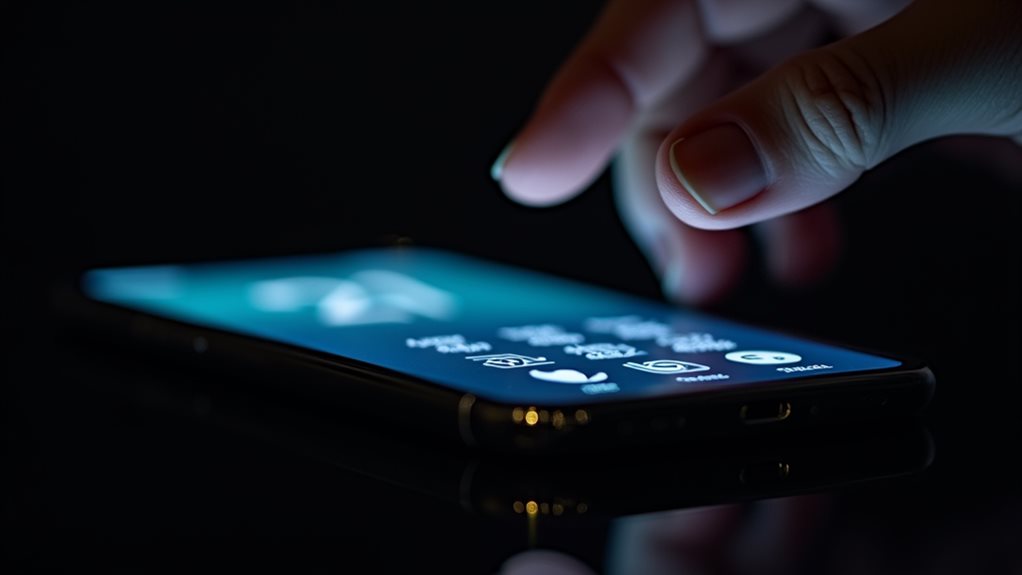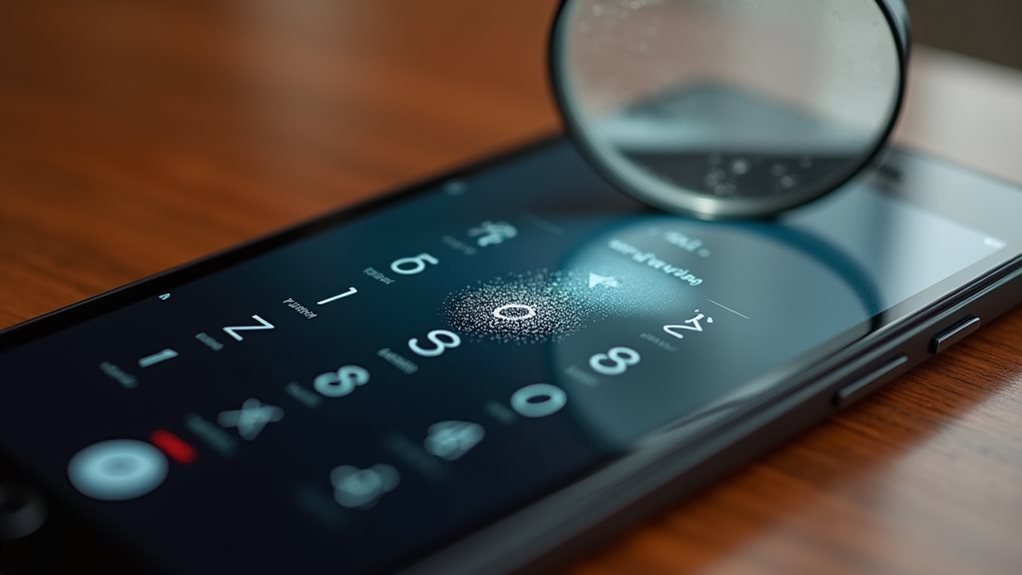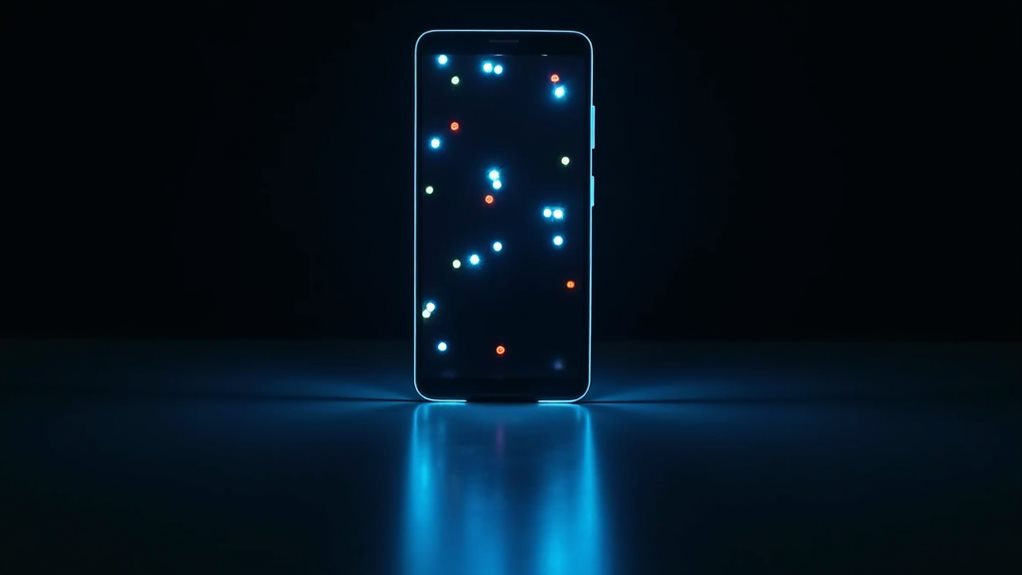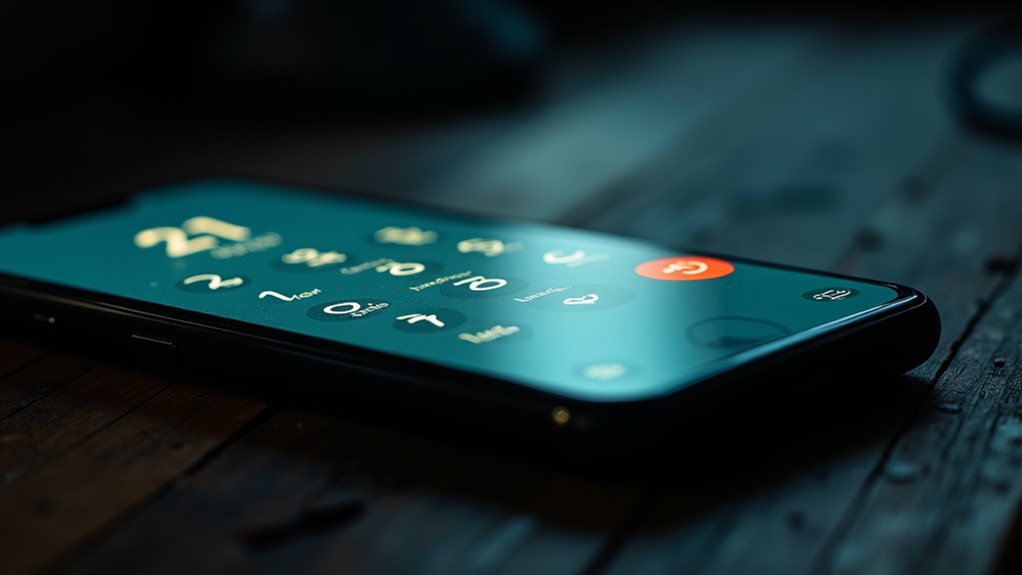Several diagnostic codes can help you check if your phone's being monitored. Dial *#21# to verify call forwarding status, *#62# to check unreachable call redirections, and *#67# to examine all forwarding settings at once. For detailed device information, Android users can enter *#*#4636#*#*, while iPhone users should try *3001#12345#* for Field Test mode. You'll also want to watch for warning signs like unusual battery drain, unexpected data usage, or strange sounds during calls. These codes serve as your first line of defense, but understanding additional security measures will strengthen your privacy protection.
Understanding Phone Monitoring Codes
In today's digital age, phone monitoring codes serve as valuable tools to help you detect potential surveillance on your mobile device. These codes, when dialed correctly, can reveal if someone's monitoring your calls, messages, or location data. You're not alone in wanting to protect your privacy, and understanding these codes is your first line of defense.
Several crucial phone monitoring codes can help you check different aspects of your device's security. By dialing *#21#, you'll discover if your calls are being redirected elsewhere, while *#61# reveals unconditional call forwarding status. For thorough surveillance detection, use *#67# to examine all call forwarding settings at once. Technologies like StingRay devices can intercept data from nearby phones without users knowing. Regular antivirus software scans provide additional protection against potential spyware and malware threats.
Code usage becomes particularly important when you suspect unauthorized monitoring, as these combinations can quickly confirm or dismiss your concerns.
If you're worried about location tracking, the netmonitor codes *#*#197328640#*#* for Android and *3001#12345#* for iPhone provide detailed information about your device's network connections.
These codes give you immediate access to crucial data about your phone's security status, helping you maintain control over your digital privacy.
Signs of Phone Surveillance
While monitoring codes can help detect surveillance, recognizing physical signs of phone tampering is equally important for protecting your privacy. Your phone's behavior can reveal when something's not quite right, helping you stay ahead in spyware detection and maintaining your phone privacy.
You'll want to watch for several telling indicators that suggest surveillance. If you're noticing unusual sounds during calls, like clicking or static, or if your phone's lighting up without notifications, these could be red flags. Two-factor authentication adds crucial protection against unauthorized access.
Pay attention to your battery life – if it's draining unusually fast or your phone's getting hot, spyware might be running in the background. Unexpected data usage spikes and strange text messages containing random characters shouldn't be ignored either. Once installed, malicious software can continuously monitor your activities without your knowledge.
Keep an eye out for apps you don't remember installing, random camera activations, or system performance issues. If your phone's acting unusual – freezing frequently, rebooting on its own, or displaying intrusive pop-ups, it's time to investigate further.
These signs, especially when occurring together, suggest your device might be compromised and require immediate attention to protect your privacy.
Essential USSD Security Codes

You'll find USSD codes invaluable for checking if someone's monitoring your phone, with basic codes like *#21# revealing potential call forwarding setups that might indicate surveillance.
Regular security checks through USSD codes can help detect unauthorized spyware installations that compromise your privacy.
These diagnostic codes, including *#62# for unreachable call forwarding and ##002# for disabling all redirections, serve as your first line of defense against unauthorized monitoring.
Your phone's security becomes more manageable when you're armed with these codes, allowing you to detect and stop potential surveillance through simple dialing combinations that expose hidden settings and unauthorized changes. The code *#06# lets you verify your device's IMEI number to ensure your phone hasn't been cloned.
USSD Monitoring Check Codes
Several essential USSD codes can help you detect potential monitoring on your smartphone. These phone security tips are vital for maintaining your privacy and protecting against unauthorized surveillance.
To get started, dial *#06#* to check your IMEI number, which helps verify if your device has been tampered with or replaced without your knowledge. Regular code verification checks are recommended to ensure your phone's security status. A clear signal strength reading using Field Mode can also indicate if your device is functioning normally.
For a thorough device check, you'll want to use *#*#4636#*#*, one of the most valuable USSD code applications that reveals detailed information about your phone's status and network connections.
If you're concerned about GPS tracking, enter *#*#1472365#*#* to test your location services for any irregularities. iPhone users should dial *3001#12345#* to access the Field Test mode, which can expose potential tracking activities.
Don't forget to check for call forwarding by dialing *#21#* – this simple code could reveal if someone's redirecting your calls without permission.
For advanced users, #197328640#*#* activates service mode testing, allowing you to dig deeper into your device's activities and identify any suspicious behavior that might indicate monitoring.
Call Forwarding Detection Codes
Building on our phone monitoring checks, call forwarding detection codes offer a specific line of defense against unauthorized call redirection. When you're concerned about privacy concerns and potential eavesdropping, these universal codes can help you identify if someone's secretly forwarding your calls to another number.
You'll want to start with #21# to check for unconditional call forwarding – this is the most straightforward way to see if your calls are being redirected. For a more thorough check, dial #004#, which reveals all active call forwarding settings on your device. If you discover any suspicious forwarding configurations, you can quickly disable them using ##002#. The Star Hash 62 Hash code provides an additional verification method for detecting call forwarding. Regular monitoring of forwarding settings using these codes is essential, as unfamiliar processes could indicate unauthorized access.
Don't forget to verify conditional forwarding settings too. Use #62# to check if your calls are being redirected when you're out of network range, and #61# to see if someone's set up forwarding for unanswered calls.
These codes work on both Android and iPhone devices, making them universally accessible. If you find any unauthorized settings, you can reset specific forwarding types using ##61# or ##62#, ensuring your calls remain private and secure.
Phone Tapping Status Codes
Your phone's security can be verified through essential USSD codes that detect potential monitoring or tampering.
These specialized codes help you identify unusual activities and protect against unwanted surveillance, giving you control over your device's privacy.
To check for monitoring risks, start with basic security codes like *#06# to verify your IMEI number hasn't been compromised, and *#21# to detect unauthorized call forwarding.
Android users can enter *#*#4636#*#* to reveal hidden connections, while iPhone users should use *3001#12345#* for similar checks.
For thorough phone security, regularly check your network status with *#*#197328640#*#* on Android devices.
If you suspect tampering, use *##002#* to reset all call forwarding settings to default.
The code *#*#1472365#*#* helps identify GPS tracking abnormalities, which could indicate surveillance.
Remember to use *#62#* to verify your call forwarding status and *#04# to confirm your IMEI and IMSI numbers haven't been altered.
These simple checks can reveal potential security breaches and help maintain your privacy in today's interconnected world.
Phone Tapping Detection Methods
Modern smartphones offer multiple built-in methods to detect potential phone tapping or surveillance. To protect yourself, you'll want to familiarize yourself with various tapping techniques and detection tools that can reveal unauthorized monitoring of your device.
Start by monitoring your phone's behavior for common signs of surveillance. If you notice unusual battery drain, unexpected background activities, or strange noises during calls, these could indicate tapping. You should also watch for suspicious text messages containing random characters or your phone lighting up without reason.
For a more technical approach, use your phone's built-in diagnostic codes. On Android, dial *#*#4636#*#* to check for monitoring, while iPhone users can enter *3001#12345#* to access the Field Test mode.
Keep an eye on your network activity and data usage patterns, as unexpected spikes might suggest unauthorized surveillance. Your phone's accelerometer can potentially be used for eavesdropping, though this technique isn't yet reliable. Implementing strong encryption measures can help prevent interception of sensitive information.
To counter this and other threats, regularly check for unauthorized apps, monitor your data transfers, and use ##002# on Android to disable call forwarding that might enable monitoring.
Preventing Unauthorized Phone Access

While detecting phone monitoring is valuable, preventing unauthorized access in the first place offers the strongest protection for your device.
You'll want to start with robust password management and biometric security features, including fingerprint scanning or facial recognition, to create a strong first line of defense.
To safeguard your phone effectively, you'll need to implement multiple security layers.
Enable device encryption to protect your stored data, and make sure you're regularly updating your software to patch security vulnerabilities.
It's essential to manage your app permissions carefully, ensuring that only trusted applications have access to sensitive features like your camera and microphone.
Don't forget about remote access protection – always implement two-factor authentication and exit remote sessions immediately after use.
If you're concerned about unauthorized access, you can utilize Find My Device features to track and lock your phone remotely.
For additional security, consider using a Faraday bag when you need complete privacy, and maintain regular backups of your data to secure cloud storage.
Remember to monitor your device activity regularly for any suspicious changes that might indicate unauthorized access.
Advanced Phone Security Tools
You'll want to start your phone security assessment with reliable network monitoring applications, which can detect unusual data patterns and potential surveillance activities.
Signal analysis software offers an additional layer of protection by examining your phone's radio frequencies and identifying suspicious transmission patterns that might indicate monitoring.
These advanced security tools, when combined with regular USSD code checks, create a robust defense system against unauthorized surveillance of your device. Implementing strong user authentication methods can further enhance your phone's security against monitoring threats.
Network Monitoring Applications
Network monitoring applications serve as powerful tools to detect potential surveillance and intrusive activities on your phone. When you're concerned about your device's security, these advanced security applications can help you identify unauthorized access and protect your personal information.
Popular network monitoring tools like Fing and IP Tools let you scan your network connections, detect suspicious devices, and monitor your WiFi activity. You'll find extensive features that include device discovery, threat detection, and real-time alerts when something's amiss.
More sophisticated solutions like SentinelOne Singularity Mobile and Cortex XDR Mobile use AI-powered analysis to identify potential threats before they compromise your device. Implementing strong security measures like multi-factor authentication can further enhance your defense against unauthorized access.
These applications don't just monitor – they actively protect you through multiple security layers. You'll get instant notifications about unsafe WiFi connections, compromised devices, and malicious apps trying to access your network.
The best part is that modern security tools are designed to work efficiently without draining your battery or consuming excessive bandwidth. With features like jailbreak detection and vulnerability management, you're equipped to maintain control over your device's security while staying connected.
Signal Analysis Software
Signal analysis software represents the cutting edge of mobile security technology, offering sophisticated tools to detect and analyze potential surveillance threats. When you're looking to secure your device, you'll find that modern signal analysis tools combine multiple advanced features to keep your communications private and protected.
The most reliable solutions incorporate Signal Encryption protocols with robust trust mechanisms, ensuring your messages remain confidential. You'll benefit from biometric security options that work alongside registration lock features, making it considerably harder for unauthorized users to access your device.
While group messaging capabilities keep you connected, they're fortified with key exchange protections to prevent interception.
However, you should be aware of potential vulnerabilities. SMS risks have led to the removal of certain messaging features, and phishing vulnerabilities continue to pose challenges. That's why extensive data protection measures are essential. Additionally, understanding strong security measures is critical for preventing unauthorized access and ensuring the confidentiality of your communications.
Tracking Software Warning Signals

Warning signs of tracking software can manifest in three distinct ways on your mobile device: physical symptoms, digital indicators, and behavioral changes. When you're concerned about tracking software risks, it's vital to monitor your device's performance closely for these telltale signals.
Physical symptoms often include unexplained battery drain and unusual device heating. You'll notice your battery depleting faster than normal, even when your phone's idle.
Digital indicators reveal themselves through suspicious data usage patterns and unexplained spikes in consumption that don't match your regular app activities. Pay attention if you're seeing unfamiliar apps or if existing apps request permissions they shouldn't need.
To implement effective detection techniques, use diagnostic codes specific to your device. For Android users, dial *#*#4636#*#* to check for potential phone tapping, while iPhone users should use *3001#12345#*.
You can also verify call redirects by dialing *#61#. If you notice apps crashing frequently, running unexpectedly in the background, or requesting unnecessary permissions for location and camera access, these behaviors warrant immediate investigation.
Frequently Asked Questions
Can Monitoring Codes Work if My Phone Is in Airplane Mode?
Yes, you can use monitoring codes even in airplane mode. They'll work effectively since these codes communicate directly with your phone's system, not requiring internet or cellular connections to check for monitoring activities.
How Often Should I Check My Phone for Monitoring Activity?
You should check your phone security daily for basic monitoring signs like unusual battery drain or behavior. Make weekly checks of app permissions and data usage, and run monthly full-system security scans.
Do These Monitoring Codes Work in All Countries Worldwide?
You'll find that international monitoring codes aren't universally reliable. They're primarily designed for US devices and carriers. It's best to use local security solutions and consult regional authorities in your specific country.
Will My Service Provider Know When I Use These Monitoring Codes?
Your service provider's awareness of monitoring code usage isn't fully documented, but they're likely able to see when you dial these codes. However, using them won't typically trigger any special alerts to providers.
Can Monitoring Codes Detect Government-Level Surveillance on My Device?
No, you can't detect government surveillance using standard monitoring codes. These basic detection methods won't reveal sophisticated surveillance techniques. Like many others concerned about privacy, you'll need professional tools for that level of monitoring.
Final Thoughts
You've now learned several reliable methods to check if your phone's being monitored, from USSD codes to surveillance detection tools. Remember that regular security checks, strong passwords, and updated software are your best defenses against unwanted monitoring. While no security measure is perfect, staying vigilant and implementing these protective strategies will greatly reduce your risk of unauthorized surveillance and help safeguard your digital privacy.

